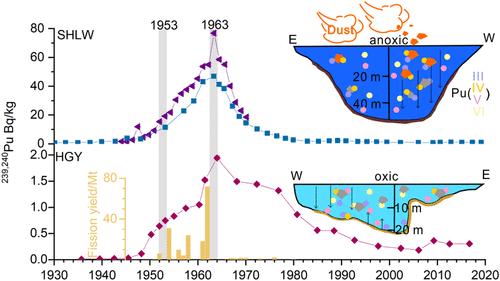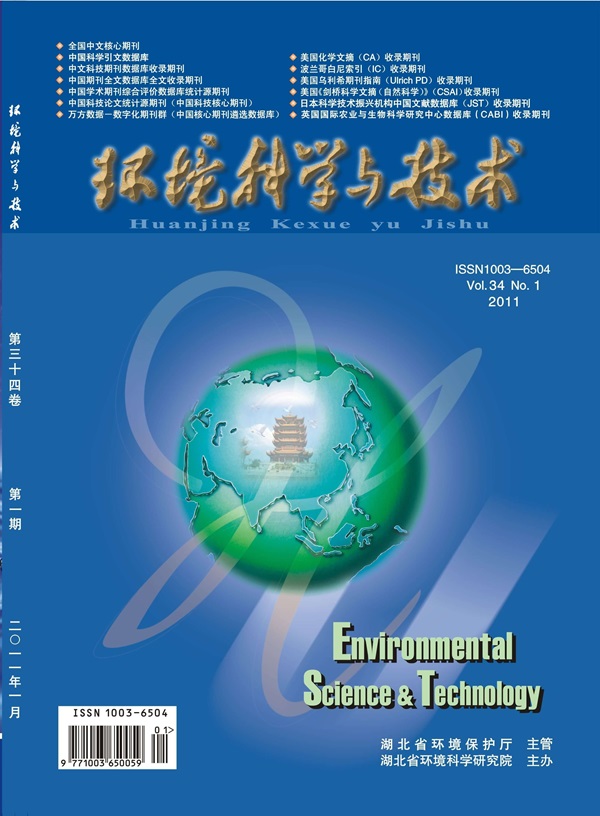Plutonium Marker for the Great Acceleration by Intensified Human Activities
IF 10.8
1区 环境科学与生态学
Q1 ENGINEERING, ENVIRONMENTAL
引用次数: 0
Abstract
There has been a sharp rise in the extent and scale of human activities since the mid-20th century, termed the “Great Acceleration”, and nuclear activities are one of the defining technological processes for this period. 239,240Pu released by atmospheric nuclear weapons tests provides an ideal chronostratigraphic marker for labeling this change due to its global fallout feature, temporal mutation, and long half-lives. However, the accumulation dynamics of plutonium from atmospheric deposition to preservation in the sediment is still controversial. Three sediment cores collected from two maar lakes with high-quality chronology were analyzed for 239,240Pu. The first high-yield thermonuclear test (31st October 1952) and the highest global tests in 1961–1962 were identified, respectively, as the first rapidly increased 239,240Pu in 1953 and peaked in 1963. In anoxic Lake Sihailongwan (SHLW), scavenging Pu from the water to sediment was accelerated due to the major particulate associated forms of Pu(III) and Pu(IV) and rapidly elevated dust flux when ice-melting occurred in every spring. The desorption of Pu from beneath sediment to the lake water and resorption by sediment particles were stronger in shallow and oxic Lake Huguangyan. Therefore, the first rapid increase of 239,240Pu in 1953 and peak in 1963 accompanied by rapid scavenging and well preservation of plutonium provide a robust time marker for the “Great Acceleration”, and this marker nearly permanently exists in such kind of lake sediment similar to Lake SHLW.

人类活动剧烈加速的钚标志
自20世纪中期以来,人类活动的范围和规模急剧上升,被称为“大加速”,核活动是这一时期决定性的技术进程之一。大气核武器试验释放的239,240钚由于其全球沉降特征、时间突变和较长的半衰期,为标记这一变化提供了理想的年代地层标记。然而,钚从大气沉降到沉积物中保存的累积动力学仍存在争议。对2个maar湖的3个沉积物岩心进行了高质量的年代学分析。第一次高当量热核试验(1952年10月31日)和1961-1962年全球最高的核试验分别被确定,第一次核试验在1953年迅速增加到239,240Pu,并在1963年达到顶峰。在缺氧的四海龙湾湖(SHLW),由于主要颗粒伴生形式的Pu(III)和Pu(IV)加速了从水中向沉积物的清除,并且每年春季发生融冰时沙尘通量迅速增加。湖光岩湖底沉积物对水体的脱附和沉积物颗粒对水体的再吸收作用在浅氧湖底较强。因此,1953年239240pu的第一次快速增加和1963年的峰值,伴随着钚的快速清除和良好保存,为“大加速”提供了一个强有力的时间标志,而这一标志在类似SHLW湖的湖泊沉积物中几乎永久存在。
本文章由计算机程序翻译,如有差异,请以英文原文为准。
求助全文
约1分钟内获得全文
求助全文
来源期刊

环境科学与技术
环境科学-工程:环境
CiteScore
17.50
自引率
9.60%
发文量
12359
审稿时长
2.8 months
期刊介绍:
Environmental Science & Technology (ES&T) is a co-sponsored academic and technical magazine by the Hubei Provincial Environmental Protection Bureau and the Hubei Provincial Academy of Environmental Sciences.
Environmental Science & Technology (ES&T) holds the status of Chinese core journals, scientific papers source journals of China, Chinese Science Citation Database source journals, and Chinese Academic Journal Comprehensive Evaluation Database source journals. This publication focuses on the academic field of environmental protection, featuring articles related to environmental protection and technical advancements.
 求助内容:
求助内容: 应助结果提醒方式:
应助结果提醒方式:


